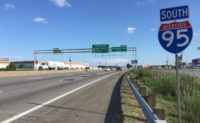I-66 Toll Lanes Receive Additional State Loan as Design Questions Persist

The Virginia Dept. of Transportation will have to spend $9 million on preliminary work for the I-66 toll-lanes project due to delays in approvals for a federal low-interest loan.
Delays in approvals for a federal low-interest loan will require the Virginia Dept. of Transportation to spend another $9 million on preliminary work for the I-66 toll-lane project. VDOT already was set to loan $30 million to Express Mobility Partners—a consortium led by Spanish toll-road developer Ferrovial and Worcester, Pa.-based contractor Allan Myers—to get the $2.3 billion, 22.5-mile P3 project underway. The delay, which is attributed to the transition of presidential administrations, caused the project to miss its scheduled financial close date, July 2017.
Pending approval by the Commonwealth Transportation Board in October, the loan increase is not expected to affect the planned 2018 start of construction on the five-year effort to expand capacity along northern Virginia's primary east-west corridor, between the Capital Beltway and Gainesville, Va. Several key design issues remain unresolved, however, including integrating the toll lanes' connections with the beltway within a space-constrained area that also includes a Metrorail station, located in the existing median.
Plans to route a project-mandated bike-and-pedestrian trail, located immediately adjacent to I-66's travel lanes near another Metrorail station, also have been heavily criticized by cyclists, residents and local lawmakers. Despite noise and safety concerns associated with the trail's current siting, relocation to the other side of the project's new sound walls would violate legal agreements with adjacent property owners.
VDOT and Express Mobility Partners hope to resolve both issues without the need to acquire additional land.
Following completion of the toll lanes, currently scheduled for 2020, Express Mobility Partners will have a 45-year concession to operate and maintain the toll lanes, which will use congestion pricing.
A separate project to implement rush-hour-only tolls on the 10-mile section of I-66 inside the beltway is largely complete, with toll-collection infrastructure installed and set to begin collecting revenue in December. The tolls will replace long-standing, rush-hour high-occupancy-vehicle regulations that were implemented in the 1970s to gain local approval for I-66's construction.




